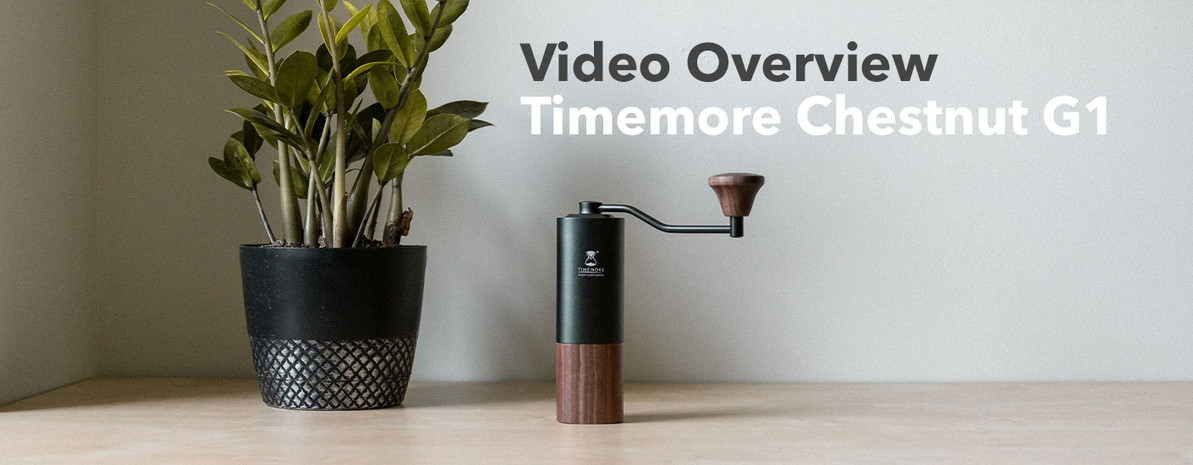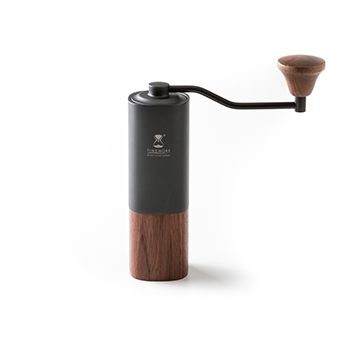Video Overview | Timemore Chestnut G1 Hand Grinder
The Chestnut G1 comes in a modernist package—a rounded cuboid shape, black walnut grinds-catch, and slate steel body—but has a distinctly Timemore interior with 38mm conical burrs, steel axle, and dual bearings. In this video, Steve highlights the unique features of the G1 and introduces the two burr options.
Transcript
Hi, I'm Steve with Prima Coffee. And today, we're going to take a look at the Timemore Chestnut G1 manual coffee grinder. G1 is the grinder for you if you care about aesthetics as much as you care about the grind quality. It's no surprise that this has won the 2017 Red Dot Design Award. It's beautiful. The G1 is influenced by mid-century modern design. It has this nice organic shape, and it has the natural materials juxtaposed to the man-made materials. So, of the man-made materials, we have an aluminum alloy body, which includes these two support beams on the inside. And we have aluminum on the inside of the grinds catch as well as the lid. The stainless steel elements include the crank arm here, the axle, and the two bearings on either side of that central column, which allow this to be a really smooth rotation. The organic shape is nicely complemented by these natural materials, including the black walnut pommel, which has a magnet on the inside and snaps into place and this black walnut grinds catch. And this is not simply a veneer. You'll see that it goes all the way around.
The grinds catch is secured by the use of these four balls on the perimeter that slide into place in these four grooves on the inside of the body. With the G1, you have two options for burrs. You have 38-millimeter stainless steel burrs that are really good for that mid-range grinding, and then you have 38-millimeter stainless steel burrs coated in titanium that are really good for medium range as well as getting into the fine range. As with all Timemore grinders, this has a stepped adjustment wheel. It's really great for finding your favorite brewing setting and then returning to it whenever you want. And how this works is you hold onto the handle, and you turn the wheel all the way to its zero point, which is when it stops moving. And that's when the burrs are touching and you won't be able to move the crank arm here. And then from there, you can just back it off counterclockwise and count the number of clicks it takes to get to your favorite setting. And you can hear that. So, this grinder comes with an instruction manual and a quickstart guide that does tell you on the inside here what the grind settings are. It'll say 6 to 12 for espresso, 15 to 24 for pour over, and 24 and up for French press and other coarse methods. We find that that's pretty accurate. Espresso, though we find that eight and nine is a really good area for that.
The coffee doesn't really start to fall into the grinds chamber all the way through the burrs until you get to about eight clicks, anyway. So, we started there, and we found that with eight, the shot was a little too long and it tasted bitter. And with nine, the shot was a little too short, and it was okay, but it tasted a little sour. The problem because it's a stepped adjustment ring, you cannot find the space between eight and nine. So do keep that in mind. You will find better performance with the stainless steel coated in titanium when you get down to those espresso-style grinds. However, again, it's stepped adjustment wheel, so just keep that in mind. There are other grinders out there if espresso is your thing. which is great for stowing or for travel, and this brush which is great for clearing away any of that retention that you'll find here between the adjustment wheel and the body. So that is the Timemore G1 manual coffee grinder. It is a beautiful design. It has a wide range for grinding, and it uses premium materials. You can find it online at primacoffee.com.




